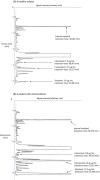Reference Intervals of Serum Non-Cholesterol Sterols by Gender in Healthy Japanese Individuals
- PMID: 31484845
- PMCID: PMC7242229
- DOI: 10.5551/jat.50187
Reference Intervals of Serum Non-Cholesterol Sterols by Gender in Healthy Japanese Individuals
Abstract
Aims: The present study was conducted to establish a practical method for measuring non-cholesterol sterols and reference intervals of serum levels.
Methods: Healthy subjects (109 men and 151 women), four patients with sitosterolemia, and 10 heterozygous mutation carriers of ABCG5/ABCG8 genes were investigated. Then, three non-cholesterol sterols (sitosterol, campesterol, and lathosterol) of fasting serum samples were measured via a practical and highly sensitive gas chromatography (GC) method with 0.2 µg/mL as the lower limit of quantification. The coefficient of variation (CV) values for within-run reproducibility were 3.06%, 1.89%, and 1.77% for lathosterol, campesterol, and sitosterol, respectively. The CV values for between-run reproducibility were 2.81%, 2.06%, and 2.10% for lathosterol, campesterol, and sitosterol, respectively.
Results: The serum levels of sitosterol and campesterol were significantly higher in women than in men, whereas the serum levels of lathosterol were significantly higher in men than in women. Because of these gender difference, the determination of reference intervals of the three sterol values was performed by considering gender. The reference intervals of sitosterol, campesterol, and lathosterol were 0.99-3.88, 2.14-7.43, and 0.77-3.60 µg/mL in men and 1.03-4.45, 2.19-8.34, and 0.64-2.78 µg/mL in women, respectively. The serum levels of sitosterol and campesterol were higher in patients with sitosterolemia (94.3±47.3 and 66.3±36.6 µg/mL, respectively) than in healthy subjects.
Conclusion: These results demonstrate a practical and highly sensitive GC method to measure non-cholesterol sterol levels and gender-segregated reference intervals of sitosterol, campesterol, and lathosterol in Japanese healthy subjects.
Keywords: Gas chromatography; Non-cholesterol sterol; Reference interval; Sitosterolemia.
Conflict of interest statement
None had conflict of interest to be disclosed in terms of the present study.
Figures
Similar articles
-
A case of ezetimibe-effective hypercholesterolemia with a novel heterozygous variant in ABCG5.Endocr J. 2020 Nov 28;67(11):1099-1105. doi: 10.1507/endocrj.EJ20-0044. Epub 2020 Jul 9. Endocr J. 2020. PMID: 32641618
-
High prevalence of increased sitosterol levels in hypercholesterolemic children suggest underestimation of sitosterolemia incidence.PLoS One. 2020 Aug 26;15(8):e0238079. doi: 10.1371/journal.pone.0238079. eCollection 2020. PLoS One. 2020. PMID: 32845916 Free PMC article.
-
Genetic basis and hematologic manifestations of sitosterolemia in a group of Turkish patients.J Clin Lipidol. 2021 Sep-Oct;15(5):690-698. doi: 10.1016/j.jacl.2021.07.001. Epub 2021 Jul 10. J Clin Lipidol. 2021. PMID: 34304999
-
Two novel variants of the ABCG5 gene cause xanthelasmas and macrothrombocytopenia: a brief review of hematologic abnormalities of sitosterolemia.J Thromb Haemost. 2017 Sep;15(9):1859-1866. doi: 10.1111/jth.13777. Epub 2017 Aug 5. J Thromb Haemost. 2017. PMID: 28696550 Review.
-
Features of chinese patients with sitosterolemia.Lipids Health Dis. 2022 Jan 18;21(1):11. doi: 10.1186/s12944-021-01619-1. Lipids Health Dis. 2022. PMID: 35042526 Free PMC article. Review.
Cited by
-
Japan Atherosclerosis Society (JAS) Guidelines for Prevention of Atherosclerotic Cardiovascular Diseases 2022.J Atheroscler Thromb. 2024 Jun 1;31(6):641-853. doi: 10.5551/jat.GL2022. Epub 2023 Dec 19. J Atheroscler Thromb. 2024. PMID: 38123343 Free PMC article. No abstract available.
-
Association of Kidney Function with Serum Levels of Cholesterol Absorption and Synthesis Markers: The CACHE Study CKD Analysis.J Atheroscler Thromb. 2022 Dec 1;29(12):1835-1848. doi: 10.5551/jat.63311. Epub 2022 Mar 5. J Atheroscler Thromb. 2022. PMID: 35249905 Free PMC article.
-
Diagnosis and Management of Sitosterolemia 2021.J Atheroscler Thromb. 2021 Aug 1;28(8):791-801. doi: 10.5551/jat.RV17052. Epub 2021 Apr 28. J Atheroscler Thromb. 2021. PMID: 33907061 Free PMC article. Review.
-
Plant sterol hyperabsorption caused by uncontrolled diabetes in a patient with a heterozygous ABCG5 variant.J Diabetes Investig. 2022 Nov;13(11):1934-1938. doi: 10.1111/jdi.13874. Epub 2022 Jul 21. J Diabetes Investig. 2022. PMID: 35730985 Free PMC article.
-
Comparison of the Japan Society of Clinical Chemistry reference method and CDC method for HDL and LDL cholesterol measurements using fresh sera.Pract Lab Med. 2021 Apr 23;25:e00228. doi: 10.1016/j.plabm.2021.e00228. eCollection 2021 May. Pract Lab Med. 2021. PMID: 34095414 Free PMC article.
References
-
- Berge KE, Tian H, Graf GA, Yu L, Grishin NV, Schultz J, Kwiterovich P, Shan B, Barnes R, Hobbs HH. Accumulation of dietary cholesterol in sitosterolemia caused by mutations in adjacent ABC transporters. Science, 2000; 290: 1771-1775 - PubMed
-
- Lek M, Karczewski KJ, Minikel EV, Samocha KE, Banks E, Fennell T, O'Donnell-Luria AH, Ware JS, Hill AJ, Cummings BB, Tukiainen T, Birnbaum DP, Kosmicki JA, Duncan LE, Estrada K, Zhao F, Zou J, Pierce-Hoffman E, Berghout J, Cooper DN, Deflaux N, DePristo M, Do R, Flannick J, Fromer M, Gauthier L, Goldstein J, Gupta N, Howrigan D, Kiezun A, Kurki MI, Moonshine AL, Natarajan P, Orozco L, Peloso GM, Poplin R, Rivas MA, Ruano-Rubio V, Rose SA, Ruderfer DM, Shakir K, Stenson PD, Stevens C, Thomas BP, Tiao G, Tusie-Luna MT, Weisburd B, Won HH, Yu D, Altshuler DM, Ardissino D, Boehnke M, Danesh J, Donnelly S, Elosua R, Florez JC, Gabriel SB, Getz G, Glatt SJ, Hultman CM, Kathiresan S, Laakso M, McCarroll S, McCarthy MI, McGovern D, McPherson R, Neale BM, Palotie A, Purcell SM, Saleheen D, Scharf JM, Sklar P, Sullivan PF, Tuomilehto J, Tsuang MT, Watkins HC, Wilson JG, Daly MJ, MacArthur DG;, Exome Aggregation Consortium Analysis of protein-coding genetic variation in 60,706 humans. Nature, 2016; 536 (7616): 285-291 - PMC - PubMed


